
|
Sale 76
Manuscript Sale
| Lot |
Photo |
Description |
Realized |
Lot 777 |
 |
Esquel the Most Beautiful Pallasite. Discovered in 1951 by a farmer in Chubut, Argentina, the single 680 Kg meteorite known as Esquel has been in great demand as the most beautiful of the rare type of meteorites known as pallasites. There are three major types of meteorites, iron, stony and stony-iron. Pallasites are stony-iron meteorites that originate from the core-mantle boundary of large planetary size asteroids that were destroyed early in the formation of the solar system. This rare type of meteorite consists of iron-nickel from the core of the asteroid as well as olivine crystals known as peridot from the mantle. Peridot crystals (the gem state of olivine crystals) are the only known gem stones from space found in meteorites. Esquel is considered to be the most beautiful of all pallasites and in now rarely available as the single discovered meteorite has been completely sectioned with only the main mass end piece remaining. This very large 74 x 57 x 4 mm section of Esquel has been polished on both sides to get the maximum reflection of the iron-nickel matrix as well as displaying many beautiful translucent lightly shocked green to orange olivine crystals. It weighs a hefty 63.2 grams and is dramatically displayed on a 2 inch illusion stand. Nice quality Esquels are now selling for more than $40 per gram when available.
Add $20 for domestic shipping. Estimated Value $2,500 - 3,000
View details and enlarged photo
| Unsold |
Lot 778 |
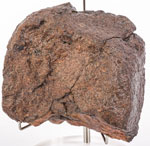 |
Huge Stony Meteorite. Most stony meteorites are small because the larger stony meteorites usually break apart or explode before they contact the earth. This large 4 x 3 x 2 inch 910 gram two pound complete stony is one of the exceptions. It is designated as an unclassified NWA meteorite meaning that it was found by Berbers in the Sahara desert of Morocco and has not been sent into the meteorite institute for classification. It probably is an ordinary chondrite which means that it consists of round silicate grains that formed at the very beginning of the solar system 4.55 billion years ago from molten globs of accreted material that stuck together to form the asteroid from which this meteorite was blasted off when two asteroids collided millions of years ago. All stony meteorites contain iron and are designated as either low or high iron and are quite heavy for their size. This meteorite is completely original just as found in the desert with nearly complete dark brown fusion crust except for a small section on the bottom side. Fusion crust is the thin dark brown layer that forms from the high heat when the meteorite passes through the earth's atmosphere. This museum quality stony meteorite is one of the top 5% of recovered meteorites and comes with a 4 inch Illusion stand for display.
Add $20 for domestic shipping. Estimated Value $550 - 700
View details and enlarged photo
| Realized
$510 |
Lot 779 |
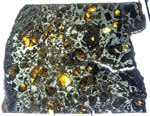 |
Meteorite Admire Pallasite. Pallasites are the rare type of meteorites that came from the core-mantle boundary of a very large asteroid that was destroyed by impact early in the formation of our solar system. It is a stony-iron with a iron-nickel matrix interspersed with olivine crystals. The Admire Pallasite was first discovered near Admire Kansas in 1881 even though it fell to earth some 15,000 years ago.
This large section is 4.75 x 3.75 inches and 0.4 cm thick weighing a hefty 224.1 grams and is loaded with olivine crystals with about 50 percent of the surface covered in olivine with the rest being iron-nickel. More than one dozen of the olivine crystals are translucent with some approaching gem quality. The color of the crystals varies from yellow- green to a deep peridot green color. One of the olivine crystals is very large 14mm and has a nice green color with some yellow-orange and its periphery. The Admire Pallasite is one of the most beautiful of all known pallasites and is unique in pallasites in that some of the olivine crystals have a characteristic called chatoyancy. Chatoyancy is defined as the change of luster within a gemstone due to the way the crystals reflect light. This rare occurrence is caused by tiny void tubes which appear like the effect of fiber optics when the gemstone is cut parallel to the tubes. This effect can be observed in some of olivine crystals of the Admire Pallasite when viewed in low light as the crystals seem to turn on and off by themselves. Comes with a 4 inch Illusion stand for display.
Add $20 for domestic shipping. Estimated Value $1,200 - 1,800
View details and enlarged photo
| Realized
$1,200 |
Lot 780 |
 |
Meteorite Campo Del Cielo 71 Pounds With a Burn Hole. These new Campo del Cielo iron-nickel meteorites have an esthetic shape with its iron-nickel surface covered with desirable regmaglypts (thumbprints) that formed when the meteor passed through Earth's atmosphere and the troilite in the meteorite melted. In addition to its beautiful esthetic shape this very large 71 pound 13 x 8 x 8 inch complete meteorite has many medium to large sized regmaglypts scattered all over its surface as well as a large 1.5 inch burn whole. First recorded by the Spanish in 1576, the huge fall of Campo del Cielo (Valley of the Sky) iron-nickel meteorites occurred thousands of years before. The best quality Campos such as this splendid specimen were recovered high in the mountains where their surface was not rusted away by ground water. The Campo field has been mostly explored and the price of quality Campos is rising dramatically as new specimens are getting to be very difficult to locate and demand for meteorites has been steadily increasing. A five pound Campo del Cielo meteorite sold for over $3000 in a New York auction in September, 2007.
Add $75 for domestic shipping. Estimated Value $5,000 - 6,000
View details and enlarged photo
| Realized
$3,360 |
Lot 781 |
 |
Meteorite Containing Salt Crystals and Water. A very important meteorite was a witnessed fall on August 4, 1998 on a mountain in the vicinity of Zag, Morocco. This H3-6 stony meteorite is so important to science because it is one of just three meteorites found that contain salt crystals (Halite) and small amounts of water. What makes this meteorite so important is that radioisotope dating shows that both the Halite (sodium chloride) crystals and water formed within the first 2 million years of the formation of our solar system over 4.57 billion years ago. The radioactive decay of various material in the large asteroid provided enough heat to melt and evaporate most of the water leaving the salt crystals and inclusions that contain water. This water is older than any water found on Earth. It is believed that the parent body for the high iron type ordinary chondrites such as Zag is Asteroid 6 Hebe which has a diameter of about 120 miles.
This lot contains both a complete uncut fragment of Zag that is 1.75 x 1.3 inches with 40% fusion crust weighing 53.5 grams and a 1.5 x 1.4in 24.589 gram polished slice with fusion crust on three sides. The slice shows the interior of Zag with its white and brown chodrules, flecks of iron and larger dark brown inclusions from the impacting smaller asteroid that collided with 6 Hebe some 300 million years ago. Both specimens are housed in a 8 x 6 inch Riker mount.
Add $15 for domestic shipping. Estimated Value $600 - 800
View details and enlarged photo
| Unsold |
Lot 782 |
 |
Meteorite From Biggest Meteor Strike Since 1907. At 9:20 A.M. on the morning of February 15, 2013 a large 8-10 ton 50 foot long meteor exploded 10-15 miles above the ancient city of Chelyabinsk, Russia with the force of over 500,000 tons of TNT 10 times the force of the atomic bomb that destroyed Hiroshima in 1945. More than 1,500 people were injured from flying glass and debris from the resulting shock wave. This was the largest meteor event in the last 100 years since a large meteor exploded over a remote area of Siberia in 1907. The official name of this meteorite is Chelyabinsk where most of the injuries occurred but most of the meteorite specimens were found on the frozen surface of Chebarkul Lake which is a frozen fresh water lake that is located directly in the meteorite strewnfield about 50 miles west of the city of Chelyabinsk. It is both on this snow covered lake and the surrounding forest where most of the pieces of the stony chondrite LL5 SR4 meteorite were recovered. Because of the immense explosion and ablation through Earth's atmosphere, most of the meteor was either burned up or blasted into a fine powder. More than 95% of the recovered meteorites are extremely small, less than 3 grams in weight.
This beautiful fresh 37 x 26 x 12 mm complete specimen weighs 27.2 grams which is much larger than the vast majority recovered. It has a fresh dark brown fusion crust covering more than 60% of the meteorite with the bottom side offering a window inside of the meteorite showing its light gray matrix mixed with specks of iron and rust orange chondrules. This stony chondrite is designated as LL5 SR4 meaning that it is of low iron even for a stony meteorite with the total iron content to be about 10 percent. It is not possible to obtain a fresher meteorite and it is very valuable for study in that there has been no contamination with Earth rocks and erosion. Comes housed in a 8 x 6 inch Riker mount with a photo of the explosion.
Add $20 for domestic shipping. Estimated Value $2,000 - 3,000
View details and enlarged photo
| Realized
$1,320 |
Lot 783 |
 |
Meteorite From Meteor Crater. This esthetic 3.5 x 3 x 1 inch over 1 pounds (456grams) Canyon Diablo iron-nickel meteorite is a palm sized specimen of one of the most sought after iron meteorites by collectors. Most currently available Canyon Diablo meteorites are just a few grams in weight. Any sizeable specimens are hard to come by as the area around Meteor Crater near Winslow, Arizona has been closed for years. The nearly one mile in diameter crater was created over 50,000 years ago when a 50 foot in diameter meteor exploded high over the Arizona desert. This excellent quality meteorite possesses all of the qualities desired in a Canyon Diablo meteorite, excellent shape looking somewhat like a small early human hand axe with sharp edges attesting to the explosive force that broke up the huge meteorite, gunmetal color and several shallow distinctive regmaglypts (thumbprints) of varying sizes. Since no specimens are available from the source at Meteor Crater, the only way to acquire a specimen is when specimens are made available from collections. Comes on a 3.5 inch illusion stand for display.
Add $15 for domestic shipping. Estimated Value $550 - 700
View details and enlarged photo
| Realized
$840 |
Lot 784 |
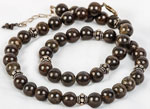 |
Meteorite Jewelry Necklace With Large Silver Spacer Beads. This 19.5 inch long plus a 2 inch long sterling silver extension handmade meteorite necklace is made up of 45 8mm round NWA 869 stony meteorite beads as well as 8 interspersed large sterling silver Bali style spacer beads and a sterling silver lobster-claw clasp. At 3.57 billion years old, these meteorite beads are older than any rocks or gemstones on Earth and have small pieces of chondrites in the medium brown matrix that authenticate them as being from a meteorite as no rocks on Earth today have chondrites in them as the chondrites that were present when the Earth formed have been lost to volcanic activity over the last 3.57 billion years. These beads are very expensive to produce because more than 80% of the meteorite is lost in their production. Comes with a certificate of authenticity.
Add $15 for domestic shipping. Estimated Value $400 - 550
View details and enlarged photo
| Realized
$480 |
Lot 785 |
 |
Meteorite Jewelry Stony Meteorite and Moldavite. This lot offers a very rare opportunity to purchase jewelry that was handmade out of genuine stony meteorites and custom designed to represent the ultimate in fine jewelry. To be able to cut up meteorites to make jewelry is a rare luxury due to the rarity and high value of nearly all meteorites. Fortunately enough meteorites were found in 1999 in Algeria of one large fall (almost 1500 Kg) to allow a small portion to be made available to be used in jewelry. There will not be any more cut into jewelry since as much as 80% of the meteorite is lost in the cutting. The stony meteorite has been assigned the name of North West Africa 869 and has been classified as an L4 or L5 breccia. All stony meteorites contain iron and all designated with a H for high iron content or L for low iron content and breccia means that the meteorite is a mixture of several different types of rocks that were mixed together when the two asteroids that created this meteorite collided billions of years ago.
This unusual meteorite necklace is 17 inches long including a 2.5 inch sterling silver extension and is made up of over 90 polished irregular shaped NWA 869 meteorite pieces and has a large 1.25 inch gem quality piece of Moldavite in a custom sterling silver bezel. Moldavite is a translucent green glass that formed from a meteorite impact in Germany over 20 million years age that formed the Ries-Nordlingen crater and today is found over 250 miles away in the Czech Republic. Moldavite is considered to be a gem stone and even today is quite often given by a groom to his bride in the Czech Republic. Comes with a certificate of authenticity.
Add $15 for domestic shipping. Estimated Value $500 - 700
View details and enlarged photo
| Realized
$408 |
Lot 786 |
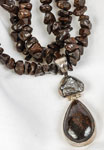 |
Meteorite Necklace With Pendant Jewelry. This 19 inch long necklace with 2 inch long sterling silver extension is made up of over 90 individual chips from the stony meteorite NWA 869 and has a two inch long sterling silver pendant attached. The pendant is made up of a one inch tear drop shaped cabochon made from a diffierent stony meteorite NWA 1389 (L6 chondrite) polished to show the individual chondrites and flecks of iron in its matrix and also a silver colored nugget made from a Sikhote-Alin iron-nickel meteorite from Russia. Comes with a certificate of authenticity.
Add $15 for domestic shipping. Estimated Value $400 - 600
View details and enlarged photo
| Realized
$394 |
Lot 787 |
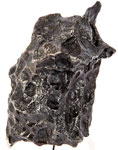 |
Meteorite Sikhote-Alin With Regmaglypts. This good size, 3 x 1.75 x .1.25 inch, 357.8 gram Sikhote-Alin iron nickel meteorite is the rarer of the two types possessing regmaglypts, small crater-like impressions that formed by ablation of Troilite when the meteorite was streaking through the sky at high temperature. The large meteorite body broke up twice during its fall to earth with only the higher breakup creating the meteorites with the regmaglypts, the lower breakup creating the shrapnel type meteorites. The shape of this meteorite is special in that it is covered with various sized regmaglypts and a sharp central peak on top and there are even some delicate flow lines remaining from the melting that took place during the meteorite passing through the earth's atmosphere. Having fallen on Feb. 12, 1947 in Siberia, Sikhote-Alin iron-nickel meteorites are the best preserved of all known iron-nickel meteorites. It is now quite rare to find such a large esthetic specimen as the meteorite field has been well searched and only small specimens are still being found. Illusion display stand included.
Add $20 for domestic shipping. Estimated Value $1,000 - 1,500
View details and enlarged photo
| Unsold |
Lot 788 |
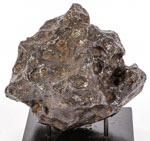 |
Paraguay Iron-Nickel Meteorite. A relatively new find of iron nickel meteorites in Paraguay has yielded some highly esthetic meteorite specimens. These iron-nickel meteorites are similar to Campo del Cielo and Sikhote-Alin meteorites in chemical and structural make-up but much rarer than either of those falls. They are Group I coarse octahedrite irons. Even though the strewnfield is near Las Palmas, Paraquay, about 200 miles east of the Campo del Cielo strewnfield in Argentina, the best specimens of this much smaller find resemble the Sikhote-Alin meteorites more than the less esthetic looking Campos. It has been determined that the Paraguay fall was from a different meteor shower than the Campo del Cielo fall.
This large magnificent specimen is 4.75 x 4.5 x 13 inches and weighs 2636 grams(over 5.75 pounds). What makes it truly special is its esthetic shape filled with small regmaglypts resembling a Sikhote-Alin with regmaglypts. This museum quality Paraguay iron-nickel meteorite is much larger than the few specimens found with most being less than 500 grams.
Add $25 for domestic shipping. Estimated Value $2,500 - 3,500
View details and enlarged photo
| Unsold |
Lot 789 |
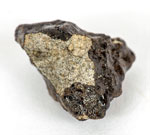 |
Tissint Martian Meteorite. At about 2 A.M. on July 18, 2011 a bright fireball was observed by several people in the Oued Dran Valley east of Tata, Morocco. The intense fireball was at first yellow in color and then turned green before breaking into several pieces resulting in two sonic booms. The first pristine meteorites were found in October 48 km SSW of Tissint Village. Any meteorite recovered from an observed fall becomes highly sought after and highly valued but Tissint was not just any meteorite, it turned out to be a very rare meteorite that originated on the planet Mars. This meteorite was identified as being from Mars by analyzing its oxygen isotopes. The composition of the oxygen isotopes from Mars is different from the composition of the oxygen isotopes from Earth and just like a fingerprint identifies this meteorite as being from Mars.
Because this meteorite is so fresh and was recovered within weeks of its fall in an arid desert, it has tremendous potential for scientists to analyze it to determine the conditions on Mars at the time it was formed and even possibly to find organic matter that might indicate the presence of life. In April 2012, a team of scientists at the Buckingham Center for Astrobiology and Cardiff University led by Professor Chandra Wickramasinghe and PhD student Jamie Wallis have indeed found what they claim to be signs of fossilized life in the Tissint meteorite. Using a powerful electron microscope they found tiny egg-shaped carbon rich globules from the interior of one of the Tissint Martian meteorites. Jamie Wallis believes that these organic spheres are proof of fossil life on Mars 400-500 million years age and are probably remnants of polysaccharide shells surrounding algal type cells. Other scientists are currently trying to confirm these findings.
Bubbles within the meteorite could still contain traces of the Martian atmosphere. The glossy black fusion crust looks like glass being so fresh and the interior is a pale gray color with some pale yellow olivine macrocrysts. The host rock solidified out of Martian magma 400-500 million years age and was blasted off the surface of Mars by an asteroid impact around one million years ago.
The largest 2.4 pound Tissint meteorite was purchased by the British Museum for over one million dollars and is considered to be the most important meteorite in their collection and the most important meteorite fall in over 100 years. This museum quality specimen measuring 12 x 11 mm and weighs 1.05 grams with more than 75% pristine glassy black fusion crust and from the exposed interior a view inside the meteorite revealing a light gray matrix with some rust brown inclusions. Presented in a 8 x 6 inch Riker mount with a picture of the egg globule and Mars. The only way to get a fresher piece of the planet Mars would be to go there and pick one up
Add $20 for domestic shipping. Estimated Value $2,000 - 3,000
View details and enlarged photo
| Realized
$1,200 |
Lot 790 |
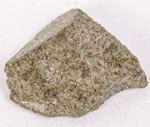 |
Zagami Historic Martian Meteorite. Meteorites from the planet Mars are so rare that usually only small fragments are available for sale. These rare meteorites have been identified as being from Mars because of their oxygen isotope analysis and crystallization age of 150-200 million years. They are younger than most of the meteorites from the asteroid belt that were formed at the same time as the solar system 4.5 Billion Years Ago. It is now believed that most if not all the Martian meteorites originated from one gigantic meteorite impact that left the more recent Zumba crater in the Daedalia Planum on Mars. Zagami was one of the first Martian meteorites found near Zagami Rock, Katsina Province, Nigeria on October 3, 1962. It was an observed fall which makes it even rarer as only a very few Martian meteorites share this distinction. It was designated as a rare Basaltic Martian Shergottite that was ejected from the large impact that occurred on Mars millions of years ago. This sizeable 11 x 10 mm segment weighs .8 gram and has the distinctive fine grained greenish gray basalt matrix that defines the Zagami meteorite and proves its volcanic origin on Mars. It is much larger than the usual grain sized specimens and can be easily studied for detail and held in one's hand for a unique Martian experience. For protection it is contained within a 1.35 x 1.35 inch membrane box which can be removed and examined from all angles and a 4" x 3" Riker mount.
Add $15 for domestic shipping. Estimated Value $800 - 1,200
View details and enlarged photo
| Realized
$528 |
Lot 791 |
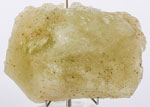 |
Libyan Desert Glass. Tektites are a mixture of earth rocks mixed with a sprinkling of meteorite material from an immense explosive event that occurred when a very large rocky meteorite vaporized before impacting the earth. The resulting mixture forms glass-like mixture. The color is usually black but it can also be green or yellow depending on the amount of silica present. This huge 5 x 3.5 x 2.75 inch 896 gram (nearly two pounds) specimen of Libyan Desert Glass is unusually pristine from being buried in the Sahara sand (near the border of Libya and Egypt) with no sandblasting on the surface and a surface covered with small craters formed when gasses escaped when the glass solidified. It is a rather uniform medium greenish yellow color and somewhat reflective on all sides except for the flat bottom. Throughout the specimen there are small white spheres of Cristobalite which is a form of quartz that only forms at very high temperatures above 1470 degrees centigrade. The presence of Cristobalite proves the meteorite impact origin of Libyan Desert Glass as the only other way it could form in the desert would be from a volcano and there was never a volcano anywhere near this area. Such a large pristine piece of Libyan Desert Glass is rarely encounterd and is especially valuable as a small 125 gram specimen sold for over $6000 in a New York auction in October, 2007. Comes displayed on a 4.5 inch Illusion stand.
Add $20 for domestic shipping. Estimated Value $800 - 1,200
View details and enlarged photo
| Unsold |
|
|